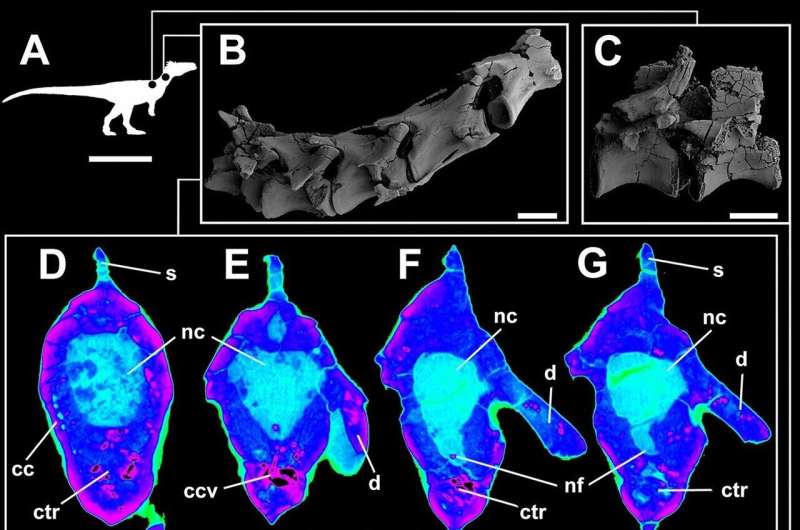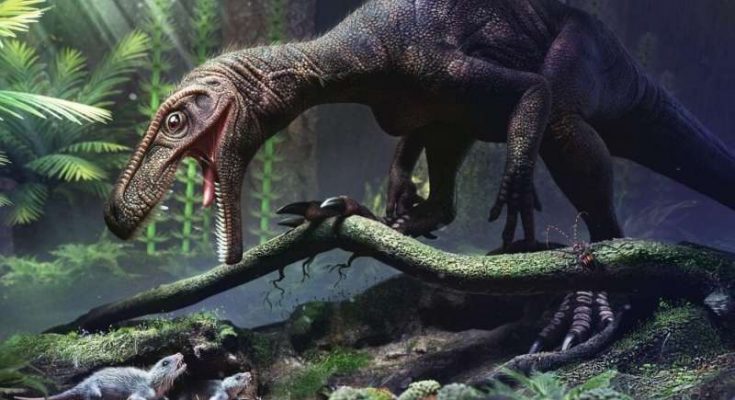Dinosaurs as big as buses or five-story buildings would not be possible if their bones were dense and heavy like ours. Like present-day birds, dinosaurs had hollow bones with inner structures known as air sacs, which made their skeletons lighter and less dense. These structures were apparently so advantageous that they emerged at least three times during the evolution of dinosaurs and pterosaurs (flying reptiles), according to a study described in Scientific Reports.
The Bakken Shale Formation—a 200,000-square-mile shale deposit below parts of Canada and North Dakota—has supplied billions of barrels of oil and natural gas to North America for 70 years. A new discovery reveals that the rocks also open a uniquely informative window into Earth’s complicated geological history.
“Less dense bones containing more air gave the dinosaurs and pterosaurs [and still give birds] more oxygen circulating in their blood, as well as more agility to hunt, flee and fight, or even to fly. They not only used less energy but also kept their bodies cool more efficiently,” said Tito Aureliano, first author of the article. The study was part of his Ph.D. research at the State University of Campinas’s Institute of Geosciences (IG-UNICAMP).
Aureliano analyzed fossilized bones from three Brazilian species of the Late Triassic (about 233 million years ago), the period in which the dinosaurs emerged. All the bones were found in recent decades in Rio Grande do Sul, Brazil’s southernmost state.
Detailed knowledge of specimens belonging to different groups and dating from an early stage in their evolution provides a basis for understanding when certain traits were developed. In this case, the researchers were looking for signs of the presence of air sacs, which were commonplace in geologically more recent (and more studied) species, such as tyrannosauruses or velociraptors, and are found in present-day birds, as noted earlier. Air sacs are found in bones throughout the body next to the spinal column.
Computerized tomography was used to visualize the fossils’ internal structures. Small spaces in the vertebrae were identified as foramina for veins, arteries and marrow, and attachment points for muscles and tendons could be seen, but none appeared capable of serving as pneumatic chambers through which air might have flowed continuously.
“The Triassic was very warm and dry. What’s now Rio Grande do Sul was far from the sea in the heart of the supercontinent Pangea. In that context, more oxygen circulating in the blood would cool the body more efficiently and certainly afford a welcome advantage, so much so that it evolved at least three times independently,” said Fresia Ricardi-Branco, penultimate author of the article, a professor at IG-UNICAMP.

Pneumaticity
The fossils analyzed were found between 2011 and 2019 by researchers at the Federal University of Santa Maria (UFSM) in an area known as Quarta Colônia near Santa Maria in Rio Grande do Sul. Some of those researchers are co-authors of the article.
The fossils belonged to three species: Buriolestes schultzi, Pampadromaeus barberenai and Gnathovorax cabreirai. The first two were sauropodomorphs, the group of long-necked dinosaurs that became the largest animals to walk the planet. The third was a herrerasaurid, one of the earliest carnivorous dinosaurs. The lineage became extinct shortly after the period in which this specimen lived.
A study published in 2021 by researchers from South Africa, the United Kingdom, the United States and Canada had already shown that another dinosaur lineage, the ornithischians, also lacked structures that could have housed air sacs. This order of dinosaurs probably emerged later, in the Jurassic (between 201 million and 145 million years ago), and included the popular Triceratops.
The data collected on ornithischians, herrerasaurids and sauropods showed that air sacs evolved independently in each group. “We discovered that no common ancestor had this trait. All three groups must have developed air sacs independently,” Aureliano said.
The other groups that had air sacs were the pterosaurs (including pterodactyls) and the theropods (including tyrannosaurs and velociraptors, as well as extant birds). Although they descended from B. schultzi and P. barberenai, in the long-necked lineage, hollow bones only evolved later. Exactly when is not yet known.
“The oldest dinosaurs in the world are in South America and have been discovered only in the past two decades,” Ricardi-Branco said. “More of this kind of research needs to be done to show how the dominant organisms of the period coped with a much warmer climate than ours.”
#NorthAmericanoilsource; #Earthsdeadliestmassextinctions; #Dinosaurs





